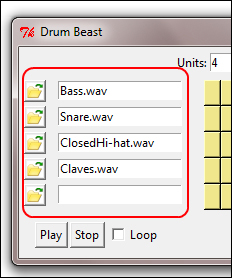Our main objective is to play sound files, in the order of a beat pattern decided by the user. To do this we need to add sound files to the drum machine.
Our program does not have any preloaded drum files. Instead, we want to let the user select from a wide variety of drum files. Thus, besides the normal drum, you can play a Japanese tsuzumi, an Indian tabla, Latin American bongo drums, or just about any other sound that you want to add to your rhythm. All you need is a small .wav or .ogg file containing that sound's sample.

Let us code the ability to add this drum sample to our program.
The drum sample is to be loaded on the left bar, as shown in the preceding screenshot. We have already created buttons with folder icons to the left-hand side of our drum pad. The desired functionality is simple.
When a user clicks on any of the left buttons, they should open a file dialog letting the user choose a .wav or .ogg file. When the user selects the file and clicks on Open, the Entry widget next to that button should be populated with the name of the file. Further, the location of the drum sample file should be added to a list for playing it later.
- First we will import the required modules. To open the sound file, we will use the
tkFileDialogmodule. We will also use thetkMessageBoxmodule to display certain pop-up messages. We will also need to extract the filename of the given sound sample using theosmodule. Let us begin by importing the three modules (given in the following code) into our current namespace (refer to the same code present in3.04.py):import tkFileDialog import tkMessageBox import os
- Next, we will add Attributes to track the loaded samples. The user will invariably load more than one drum sample. Therefore, we need to track the Entry widget where the drum sample was loaded, the location of each of the drum samples, and a number indicating the current drum number. Accordingly, we create two lists called
self.widget_drum_nameandself.widget_drum_file_nameto store the Entry widget instance and file location respectively.We also declare a variable
self.current_drum_noto track the current drum number.We choose to initialize these variables and list under our initialization method
__init__(refer to the code in3.04.py):def __init__(self): self.widget_drum_name = [] self.widget_drum_file_name = [0]*MAX_DRUM_NUM self.current_drum_no = 0
We then modify our
create_left_padmethod to include a line that appends a list of all drum Entry widgets in our newly-created listself.widget_drum_name:self.widget_drum_name.append(self.drum_entry)
- We then add a
commandcallback to the buttons in ourcreate_left_padmethod to load drum samples, as shown in the following code snippet:button = Button(left_frame, image=tbicon, command=self.drum_load(i)) - Finally, we code our
drum_loadmethod as follows (refer to the code in3.04.py):def drum_load(self, drum_no): def callback(): self.current_drum_no = drum_no try: file_name = tkFileDialog.askopenfilename(defaultextension=".wav", filetypes=[("Wave Files","*.wav"),("OGG Files","*.ogg")])Files","*.ogg")]) if not file_name: return try: delself.widget_drum_file_name[drum_no] except: pass self.widget_drum_file_name.insert(drum_no, file_name) drum_name = os.path.basename(file_name) self.widget_drum_name[drum_no].delete(0, END) self.widget_drum_name[drum_no].insert(0, drum_name) except: tkMessageBox.showerror('Invalid', "Error loading drum samples") return callbackThe description of the code is listed as follows:
- We define a callback function within our function because we need to track several drum samples.
- To track the widget, through which a sound sample has been loaded, we set the
self.current_drum_novalue to be equal to thedrum_numvalue received as an argument from the buttoncommandcallback. - In a
tryblock, we usetkFileDialog.askopenfilenameto get the filename of the drum sample. We then check whether a filename already exists in our filename list. If it does, we delete it. - Using
os.path.basenamefrom theosmodule, we obtain the filename from the file path and insert it into corresponding Entry widget. - If
askopenfilenamefails, we usetkMessageBox.showerrorto display a custom error message.
In this iteration, we imported modules to handle dialogs and message boxes. We then added attributes to track drum samples. Finally, we added command callbacks to buttons which when clicked open a dialog for the user to select drum samples.
Our code is now capable of loading drum samples and storing all necessary records that we will require to play beat patterns.
Next, let us turn our attention to playing the beat samples as per a user-defined pattern.
